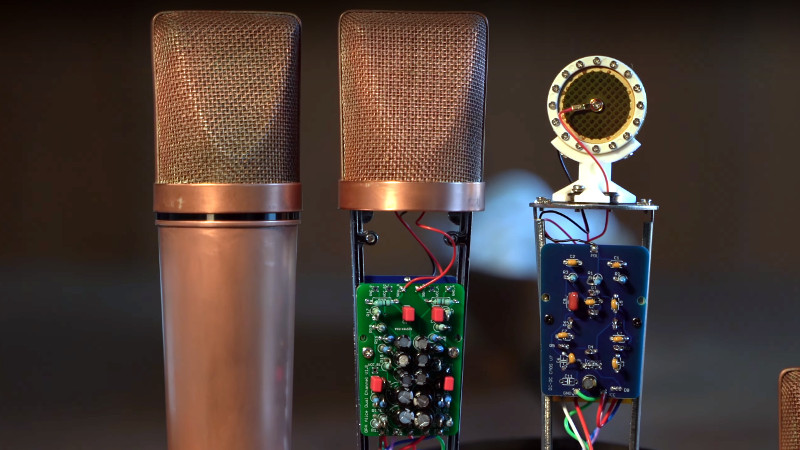There was a time when a microphone for most people was a cheap plastic affair that probably came for free with their sound card, but in the age of pandemic video streaming no desktop is complete without a chunky model that looks for all the world as though it escaped from a studio. Few people make their own microphones, so the work of [DJJules] in building very high quality condenser microphones is a particularly fascinating read.
A condenser microphone is a capacitor in which one plate is formed by a conductive diaphragm. A bias voltage is supplied to the diaphragm via a resistor, and since the charge on the plate remains constant as its capacitance changes with the sound vibrations, the voltage on the capacitor changes accordingly. This is picked up by a high impedance buffer and from there fed to a normal microphone input. This Instructable uses a commercial condenser microphone capsule, and takes the reader through generating the bias voltage for it before describing the op-amp buffer circuit.
The most interesting part comes at the end, as we’re shown how the sensitivity pattern of a dual-microphone array can be tuned to be omnidirectional, cardoid, or figure-of-eight. This is probably the norm among audio engineers, but we rarely see this sort of insight in our community. We may never build a microphone of our own, but it’s fascinating to see this one from the ground up in the video below the break.
If you’re confused about the difference between a condenser microphone and the more common electret condenser microphone, we have published a guide to that topic.

















Very cool
Mid-Side Mastering is a good read. Micing can achieve it.
You know, I’ve heard the term “condenser microphone” so many times and never connected it with “capacitor”. It makes sense though, since “condenser” is the old school term for “capacitor”. Hence why points ignition has a condenser as well.
The condenser mic was invented at Bell Labs (naturally) in the 1920s, so of course, “condenser” was/is the correct term.
Does the place or date make “condenser” correct?
Of course, last week we learned about the electret microphone and Bell Labs.
And oddly, Bell used neither microphone in their telephones, unless there was some high end or very, very late Bell phone that didn’t use a carbon microphone.
thanks god in german its clearly a “Kondensator” with its value being “Kapazität”. The latter one is thrown into a circuit to become the component known as Kondensator then
As it is a fixed point of history, then yes I would say it does, or was. :)
I had a look at how the term may have originated (remembering Leyden jars) and found this quote: “Ewald Georg von Kleist discovered the immense storage capability of the Leyden jar while working under a theory that saw electricity as a fluid, and hoped a glass jar filled with alcohol would “capture” this fluid.”
So I guess the name was adopted prior to understanding the role of the dielectric?
https://en.wikipedia.org/wiki/Leyden_jar
It looks just like a Telefunken U47.
Neumann made the U-47, not Telefunken
In the first production years, they carried the Telefunken brand name, though..
And it turns out that you can buy new ones – if you have enough money, that is. A stereo pair costs like a car..
There’s a good series of tech videos on microphones here: https://www.youtube.com/playlist?list=PLvOlSehNtuHv98KUcud260yJBRQngBKiw
I’d rather use a dynamic loudspeaker as a microphone.
Along with a simple one transistor amplifier, say, a 2N2222.
This gives a much better sound quality in comparison to the tinny sound of an average condenser mike. :)
Of course, condenser microphones are great for making spy bugs..
That’s thei primary application, isn’t it!? ;)
Nice project! I build one and it came out very well. There are some parts left. Anyone interested? Send a PM! Cheers, Tom